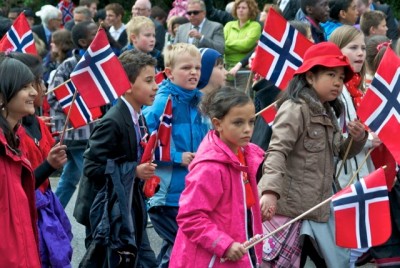While Norway often tops international charts assessing quality of life, the country ranks second in the overall well-being of its children and youth, and seventh for their satisfaction with their lives. In the charts that measure how easy young Norwegians find it to talk to their mothers, Norway lies near the bottom.

Norway came in second place after the Netherlands, in a report released by UNICEF this week that measures children’s well-being in 29 affluent countries. The report looks at five dimensions of children’s lives – material well-being, health and safety, education, behaviour and risks, and housing and environment – and Norway doesn’t top any of them, but state children’s ombud Anne Lindmoe was satisfied.
“Norway has a lot to be proud of,” Lindmoe told newspaper Aftenposten after the study was released. She thinks children deserve even more attention, though, and need to be heard: “Even though we maybe are best in the world for allowing children to participate in society and offer their opinions, they should have even more influence over their own daily life.”
Bernt G Apeland, secretary general of UNICEF in Norway, agrees that although Norway’s second-place ranking certainly isn’t bad, there are many areas where the country could do better and rise to first place. Norway ranked only fifth, for example, for its relative child poverty rates, and childhood poverty has been on the rise in the last decade. Norway also comes in ninth place for bullying. Fully 26 percent of Norwegian children who took part in the survey stated that they had been bullied in the last two months.
Low rates of smoking and drug use
Norway does, however, have the lowest proportion of young people who say they have used hash in the last year (less than 5 percent) and there’s been a big drop in the number of young people smoking. Norway nonetheless scores surprisingly low on physical exercise (in 29th place), given the national passion for sports and especially skiing, and ranks relatively high, at ninth place, for its percentage of children who are overweight; not as high, though, as its Scandinavian neighbours Denmark, in third place, and Sweden in eighth place.
It does top the list for the number of young people aged 17 to 19 who are either in school or working, with only 2.3 percent dropping out, and it has a low homicide rate among children and young people, topped only by Iceland and Austria.
Another survey from UNICEF, where children measure their own subjective sense of life satisfaction, paints a slightly different picture. Here Norway has dropped five places to number seven, below Greece and Spain. This does not surprise Willy-Tore Mørch, a professor of psychology at the University of Tromsø. “In these countries, the extended family is strong … often with more robust social networks than those that Norwegian children have. That can be more important in children’s everyday lives than good economy or easy access to material goods,” he told newspaper Aftenposten.
The figures in the report only go up to 2010, so do not reflect all the consequences of the economic crisis in Europe, or how economic cutbacks have affected families with children.
Cultural differences
An additional UNICEF survey assesses children’s relationships with their peers and parents, as these are intimately tied up with their sense of well-being. Around 4,500 Norwegian pupils aged 11, 13 and 15 participated and were asked the question “how easy or difficult is it for you to talk to others about things that really bother you?” In terms of how easy children find it to talk to their mothers, Norway is only ranked number 24 out of 28 rich countries. The Netherlands tops the charts once more, followed by Iceland, Romania and Hungary. Here again, Spain, Greece and Portugal come out higher than Norway.
These figures need to be interpreted within a cultural framework, according to Oddrun Samdal, head of research at the Department of Health Promotion and Development in Bergen (Hemil-senteret). “It seems to be a part of our culture that we prioritize having good, close friendships with our peers. The society here sends out signals that your peer group can maybe understand you better than your parents can.” She told Aftenposten that this is different in other lands, perhaps especially in Southern Europe, where “it is more customary for people to discuss difficult aspects of life more often within the extended family.”
Nurse Anne Bentzrød, who works with young people in the town of Ås south of Oslo, is not surprised that Norway ranks quite low on this list. She says that in Norway there is a tradition among young people to turn to professional counsellors and other adults for help, rather than to family. “We like to believe that our children can talk to us about anything … but we do not have that sense of belonging to the family that many other cultures have,” she told newspaper Aftenposten.
In egalitarian Norway, where it is customary for both parents to return to full-time work once the parental leave period is over, this perhaps also leaves some young people to grow up with the sense that their parents are too busy with their careers to spend much time talking with them. And in a society that has relatively well-funded institutions, there are many professionals available to talk to young people in health clinics and schools.
Despite the high level of sexual equality and sharing of parental leave and childcare among parents in Norway, children here still found that it was easier to talk to their mothers (78.7 percent) than to their fathers (65.1 percent). Boys found it slightly easier to talk to their fathers than girls did.
Views and News from Norway/Elizabeth Lindsay
Please support our news service. Readers in Norway can use our donor account. Our international readers can click on our “Donate” button:

